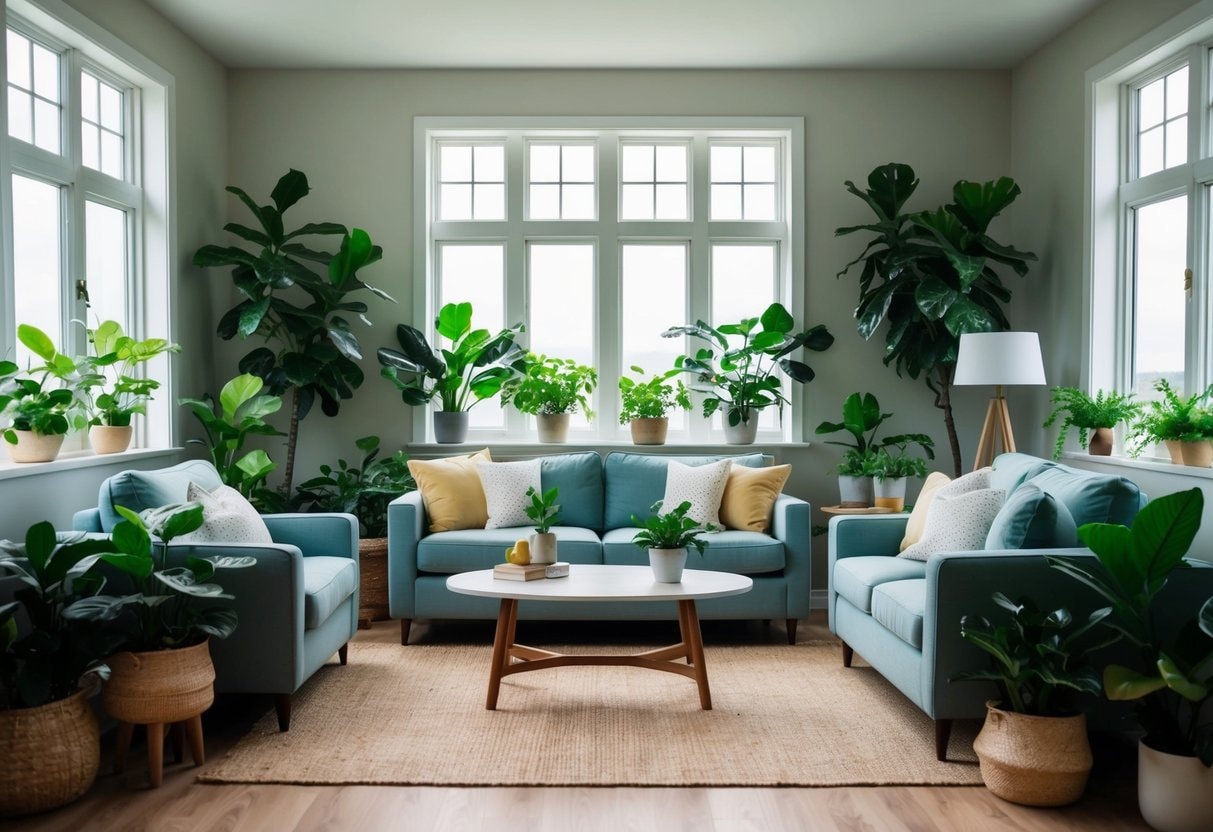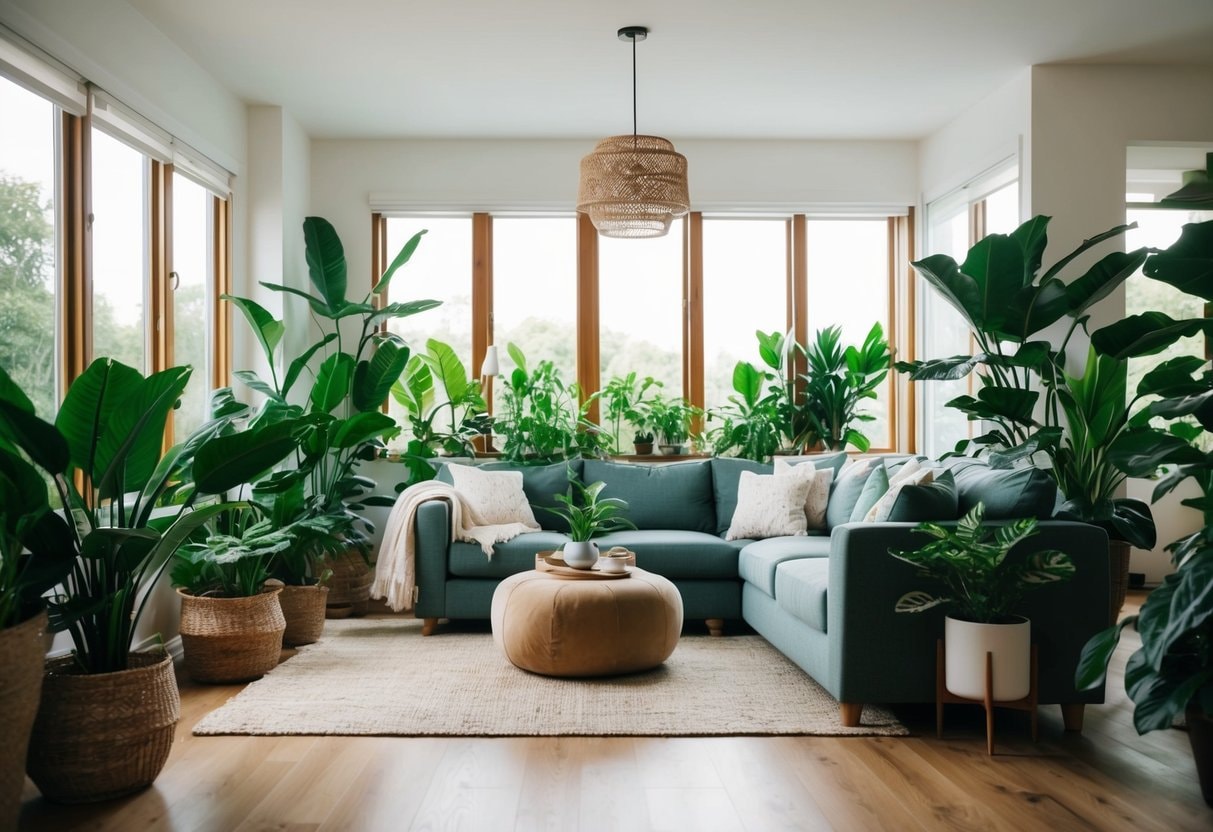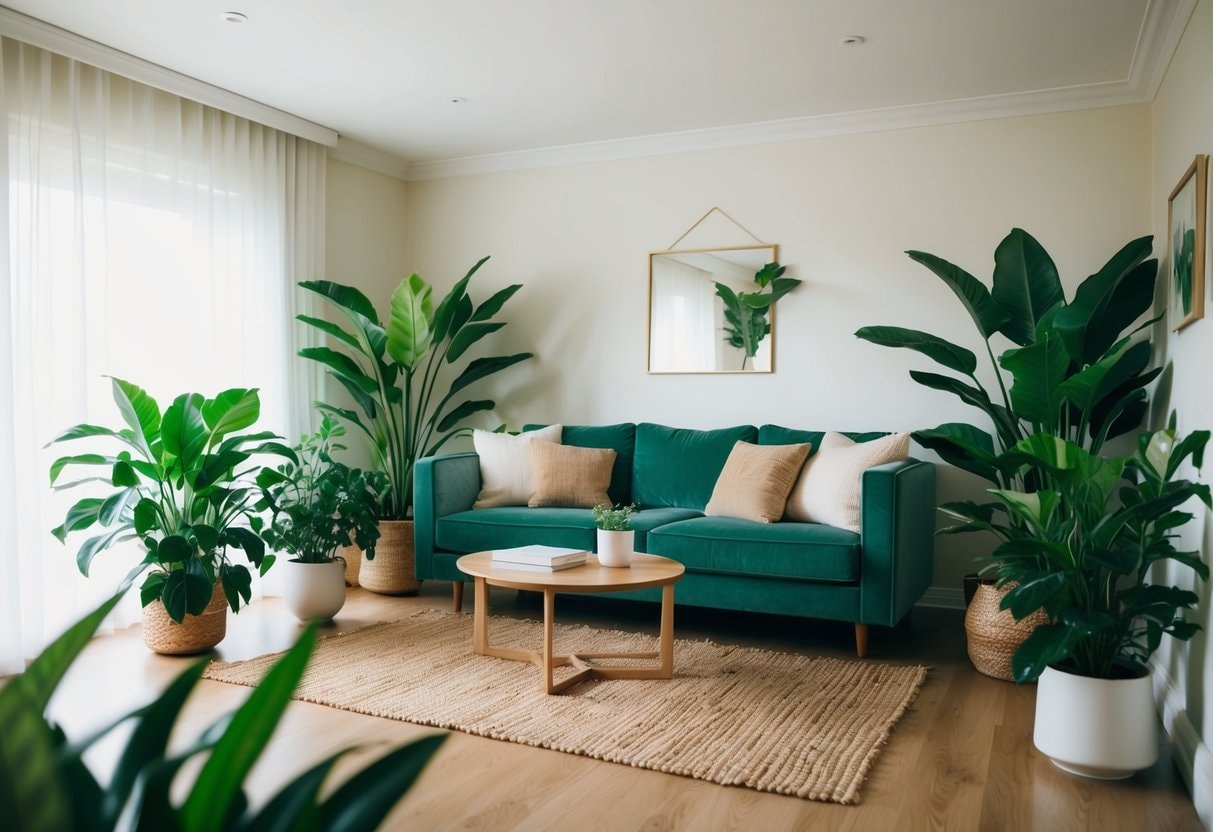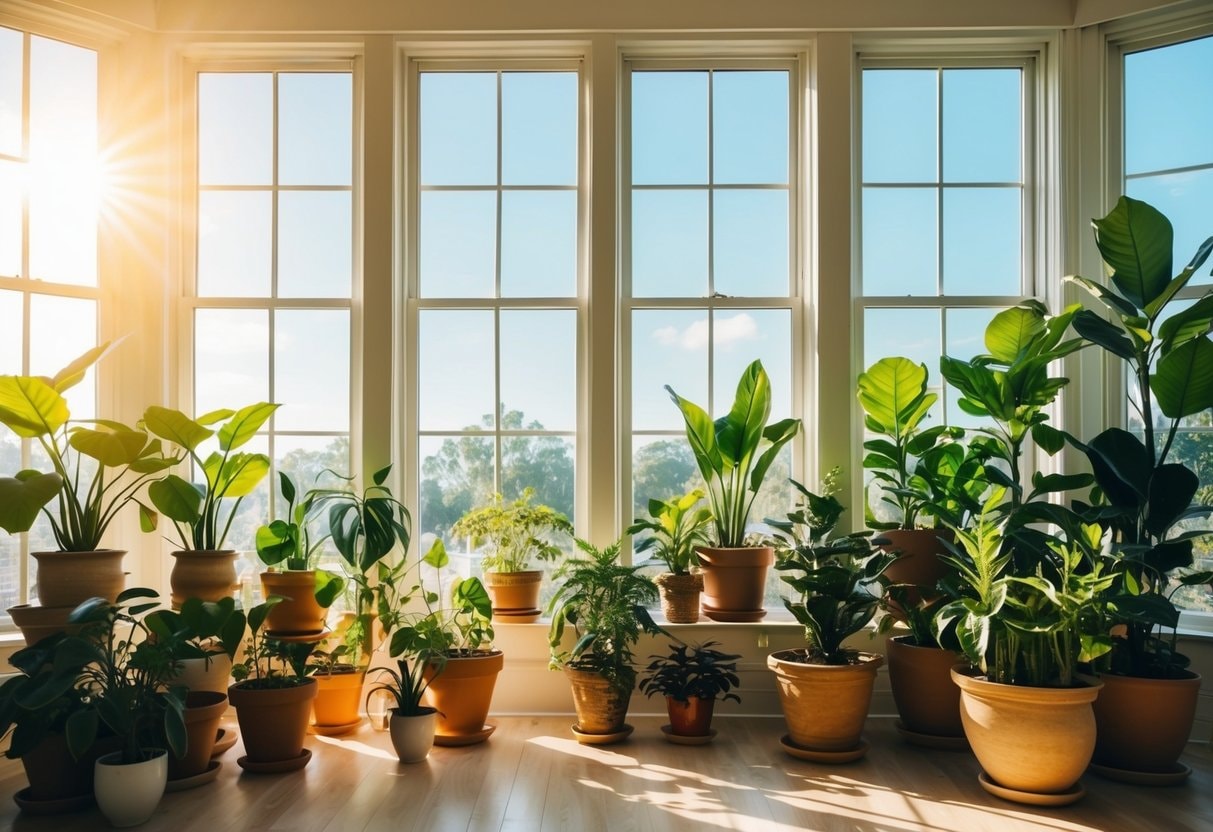HousePlantJoy is supported by our audience. When you purchase through one of our links, we may earn a small affiliate commission. As an Amazon Associate I earn from qualifying purchases. Your cost is not affected.
==================
Serenity now is within reach when you use the calming presence of plants to create a peaceful ambiance at home. With their natural beauty and soothing qualities, the right greenery can transform any space into a relaxing sanctuary. Whether it’s a cozy corner with a lush fern or a living room brightened by a tall potted tree, plants hold the power to calm your mind and ease stress, making them the perfect addition to your environment.
But it’s not just about adding any plant to your space. To truly cultivate serenity, careful thought must be given to plant selection, placement, and care. In this article, we’ll explore how you can strategically use plants to create a tranquil oasis in your home, enhancing both your well-being and the overall atmosphere. Let’s discover how to green your way to calm and design a space that nurtures peace and relaxation.
Transform Your Space: How to Create a Peaceful Home with Thoughtful Plant Placement
Creating a peaceful home environment can seem challenging, but with a serenity now mindset, it’s easier than you might think. With some thoughtful plant placement, you can transform any space into a serene oasis.
Strategic plant positioning can reduce stress, improve air quality, and boost your overall well-being. Plants have a natural ability to calm our minds and soothe our senses. By choosing the right plants and placing them in key areas, you can create a tranquil atmosphere that promotes relaxation and inner peace.
From small succulents on your desk to large potted trees in your living room, each plant plays a role in crafting your personal sanctuary. Ready to bring some serenity into your life? Let’s explore how to use plants to create a peaceful ambiance in your home.
We’ll look at selecting the best plants for different spaces, positioning them for maximum impact, and caring for them to keep your serene environment thriving.
Key Takeaways
- Carefully positioning plants can enhance a calming atmosphere, promoting relaxation and well-being.
- Choosing the right plants for each space is essential to creating a peaceful environment; consider varieties with soothing qualities or air-purifying benefits.
- Regular maintenance, including watering and pruning, helps sustain a serene ambiance and keeps plants healthy.
- Engaging with your plants mindfully can foster a deeper connection and contribute to a tranquil atmosphere.
Let’s look at some simple tips to help you place your plants well.
- Light is key. Observe how sunlight moves through your rooms. Match each plant’s light needs to the right spot. Some love bright light, while others prefer shade.
- Think about size. Give big plants space to grow. Put smaller ones on shelves or in hanging baskets.
- Group plants with similar needs. This makes care easier. Water-loving plants can go together, while succulents can form their own cluster.
- Consider airflow. Keep plants away from drafts and heat vents. Good air circulation helps prevent plant diseases.
- Use plants to soften corners and fill empty spaces. They can make a room feel cozier.
- Play with height. Mix tall and short plants to create visual interest. You can use plant stands or different pot sizes to vary in height.
- Remember function. Some plants clean the air, so put these in areas where you spend lots of time.
Understanding Light and Shade
Start by watching how sunlight moves through your space. Note which areas get bright light and which stay shady. South-facing windows often provide the most light, while north-facing ones offer gentle, indirect light.
Check for any obstacles that might block sunlight, like trees or buildings outside. These can create shifting patterns of light and shade throughout the day. Don’t forget about artificial light sources. Lamps and overhead lights can supplement natural light for plants in darker corners.
Assessing Space and Structure
Look at your room with fresh eyes. Are there empty corners or bare walls that could use some greenery? Shelves, windowsills, and coffee tables are great spots for smaller plants. Consider vertical space, too. Hanging planters or tall plants can add depth and interest to your room. Just make sure they won’t block important pathways or views.
Think about the style of your space. Choose colors and textures that match your decor. Sleek, modern pots might suit a minimalist room, while colorful, patterned planters could brighten up a bohemian space. Lastly, check for any heating or cooling vents. You’ll want to keep plants away from direct airflow to prevent drying out.
Peaceful Plant Varieties
Lavender is renowned for its calming properties. Its gentle scent can help reduce anxiety and promote relaxation. You might consider planting it near seating areas or along paths. Jasmine is another great choice. Its sweet fragrance can create a soothing atmosphere in your garden. The white flowers also add a touch of elegance.
Consider adding bamboo to your space. Its rustling leaves create a gentle, natural soundtrack. Plus, it grows quickly, providing privacy and a green backdrop. Roses aren’t just beautiful – their scent can be very calming. Choose varieties with soft colors like pale pink or white for a serene feel.
Plants That Purify Air
Some plants can help clean the air, making your garden even more refreshing. Snake plants are easy to care for and great at removing toxins from the air. Spider plants are another excellent choice. They’re known for their air-purifying abilities and are very easy to grow. You can hang them in baskets for added visual interest.
Peace lilies are beautiful and effective air cleaners. They remove common indoor pollutants and add a touch of elegance to any space. Aloe vera is not only great for skincare but also helps clean the air. It’s easy to grow and doesn’t need much water, making it perfect for busy gardeners.
Balancing Aesthetics and Function
Think about how plants look and what they do for you. Put tall plants in corners to fill empty spaces. Peace lilies can clean the air and look great by your desk. Hang plants from the ceiling to add greenery without taking up floor space.
Mix different shapes and sizes. Round-leafed plants soften sharp edges. Spiky plants add fun texture. Use pots that match your style to tie everything together. Remember, plants need care. Put them where you’ll see them often. This way, you won’t forget to water or prune them.
Creating Focal Points
Use plants to draw the eye where you want it. A big, leafy plant can be the star of your living room. Put it near a comfy chair to make a cozy reading nook. Group plants of different heights to create interest.
Put small plants in front and tall ones in back. This makes a natural, layered look. Try putting a colorful plant near your front door. It’ll make you smile when you come home. Plus, it’s a warm welcome for guests.
Ensuring Plant Accessibility
Make sure you can reach your plants easily. Put them where you can water and care for them without a hassle. If you have high shelves, use long-necked watering cans. Plants that need lots of light should be placed near windows.
But be careful – some plants can get sunburned. Use sheer curtains to filter harsh light if needed. Keep toxic plants out of reach if you have pets or kids. Put them up high or in rooms they can’t access. This keeps everyone safe while you enjoy your green friends.
Did You Know?
Plant placement can significantly influence the overall ambiance of a room. Tall plants can be positioned in corners to soften the space, while smaller plants can be placed on shelves or tables to add life at eye level. Grouping plants together creates a mini garden feel, enhancing the room’s natural and calming atmosphere.
Caring for Your Peaceful Plants
Keeping your peaceful plants happy takes a mix of regular care and attention to their needs. With the right approach, you can create an environment of serenity now for your green friends. Let’s look at the key parts of plant care to help them thrive.
Watering Routines
Peace lilies and other calm-inducing plants often need steady moisture. Water them when the top inch of soil feels dry. Don’t let them sit in water, as this can harm the roots. For most peaceful plants, watering once a week works well. But check each plant’s needs. Some may need more or less.
Use room temperature water to avoid shocking the roots. Water slowly until it drains from the bottom. Empty any excess from the saucer. If leaves turn yellow, you might be overwatering. Brown tips often mean not enough water. Adjust your routine based on what you see.
Pruning and Maintenance
Regular pruning keeps your plants looking neat and helps them grow better. Remove any brown or yellow leaves by cutting them off at the base. For flowering plants, cut off old blooms. This encourages new flowers to grow. Use clean, sharp scissors to avoid hurting the plant.
Dust leaves with a soft, damp cloth. This helps plants breathe and soak up light better. Be gentle to avoid damaging the leaves. Check for pests every few weeks. Look under leaves and along stems. If you spot any bugs, wipe them off with soapy water or use a plant-safe spray.
Seasonal Adjustments
As seasons change, so do your plants’ needs. In spring and summer, they often need more water and food. Use a balanced fertilizer every month during these growing times. In fall and winter, most plants grow slower. Cut back on watering and stop fertilizing. Move plants away from cold windows to protect them from drafts.
Adjust light as the days get shorter. You might need to move plants closer to windows or use grow lights. Keep an eye on humidity, too. Use a pebble tray or mister if the air gets too dry. Watch for signs of stress, like leaf drops or color changes. This can mean your plant needs different care as the seasons shift.
Mindfulness and Plants
Plants can play a big role in your mindfulness practice, providing serenity now as they help create a calm space for you to focus and relax. Try placing plants that promote relaxation, like lavender, near your meditation spot. The gentle scent can help ease your mind as you sit.
You can also use plants as a focus for your mindfulness. Watch how leaves move in the breeze or how flowers open up. This can help you stay in the present moment. Caring for plants can be a mindful act, too.
When you water or prune them, pay attention to each step. Notice how the soil feels and how the leaves look. Some plants to consider for your mindful space:
These plants are easy to care for and can add beauty to your space. They can also help clean the air, making your area feel fresher. You don’t need a big garden to practice plant mindfulness.
Even a small potted plant on your desk can help you find moments of calm in your day. Try touching the leaves of your plants gently. Feel their texture and temperature. This simple act can ground you and bring you into the present.
Designing Your Serene Space
Creating a peaceful garden starts with thoughtful plant placement—serenity now begins with the right choices. Color, texture, and arrangement all work together to craft a calming atmosphere.
Incorporating Color Harmony
Choose a soothing color palette for your garden. Soft blues, purples, and greens can create a relaxing vibe. Add pops of white for a fresh, clean look. Mix in some pastel flowers like lavender or pale pink roses. These gentle hues won’t overwhelm the senses.
For a cohesive look, pick plants with similar tones. You can use the color wheel to find complementary colors that work well together. Remember, too many bright colors can be stimulating. Stick to a few calming shades to keep your space serene.
Using Texture and Form
Play with different plant textures to add interest to your garden and create a serenity now atmosphere. Combine smooth leaves with fuzzy ones for a pleasing contrast. Tall, slender plants like bamboo can create a sense of height. Pair them with low, spreading ground covers for balance.
Use rounded shapes like boxwood or Japanese maples to soften hard edges in your garden. Hanging plants or vines can add a flowing, organic feel to walls or fences. This helps blur the lines between different areas of your garden.
Plant Arrangement Techniques
Group plants in odd numbers – threes or fives often look best. This creates a natural, unforced appearance. Create depth by placing taller plants at the back and shorter ones in front. This layered look adds visual interest. Use repetition to tie your garden together. Plant the same species in different spots throughout your space.
Leave some open areas in your design. Empty spaces give the eye a place to rest and make your garden feel less cluttered. Consider the views from inside your home when placing plants. Frame windows with greenery to bring the peaceful vibe indoors.
Sustaining Your Serene Ambiance
Keeping your peaceful space alive takes some effort, so remember to embrace serenity now. Regular care for your plants is key; water them as needed and remove dead leaves. Prune your plants to keep them healthy. This helps maintain their shape and size. It also encourages new growth.
Pay attention to lighting. Move plants if they’re not getting enough sun. Or add shade if they’re getting too much. Add calming sounds to boost the peaceful feel. Soft music or natural sounds work well. A small water feature can also create a soothing atmosphere.
Clean your space often. Dust plants gently and wipe down surfaces. This keeps everything fresh and inviting. Change things up now and then. Move plants around or add new ones. This keeps your space interesting and prevents boredom.
Consider adding fragrant plants like jasmine or lavender. Their scents can boost relaxation. Invite friends to enjoy your peaceful space. Sharing it can make it even more special. Remember to take time to enjoy your serene area. Sit quietly and breathe deeply. Let the calm wash over you.
Check out this video about Bringing Nature Inside and how to create a relaxing atmosphere in your home interior.
Cultivating Calm: The Transformative Power of Plants in Creating a Serene Home
Cultivating a serene atmosphere at home is entirely achievable by integrating plants into your environment. With their soothing qualities and aesthetic appeal, plants can transform any space into a personal sanctuary where one can escape from the chaos of daily life. From a tranquil corner adorned with a gentle fern to a lively living room featuring a majestic potted tree, the right selection of greenery has the power to promote relaxation and alleviate stress. This makes them indispensable companions in the pursuit of a peaceful ambiance.
However, successfully fostering serenity goes beyond merely adding a few plants to your space. It requires thoughtful consideration of plant types, optimal placement, and consistent care. By strategically selecting and positioning plants, anyone can create a harmonious sanctuary that enhances well-being. As explored throughout this article, embracing a serenity now mindset can lead to a nurturing environment that fosters peace, tranquility, and a deeper connection with nature.
What Are the Best Types of Plants to Create a Calm and Serene Environment in My Home?
Are There Specific Plants That Thrive Better Indoors for a Peaceful Living Space?
What Are Some Tips for Maintaining Plants in Different Areas of the House to Ensure They Contribute to a Tranquil Atmosphere?
Can You Suggest a Guide for Beginners on Strategically Arranging Plants for Maximum Serenity?
How Do Natural Elements Like Light and Space Affect the Impact of Plants on a Room's Serenity?
Why Become a Member of Our Community?
Unlock Exclusive Insights: Gain vital tips that will help your plants flourish and thrive like never before.
Assistance from Professionals: Connect with our knowledgeable team on social media platforms such as Facebook and Twitter. Our gardening experts are eager to support you on your plant journey.
Network with Fellow Plant Lovers: Join other plant aficionados, exchange your stories, and cultivate a nurturing community. Sign up today! Follow Houseplant Joy on Facebook, Instagram, and Twitter for daily motivation and to enhance your plant experience! #HouseplantJoy #GreenThumbsUnite #HouseplantLove









